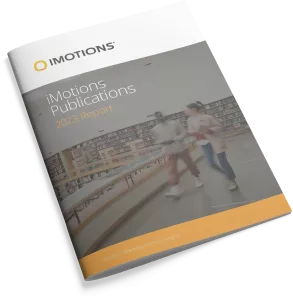-
The use of eye tracking in research on video-based second language (L2) listening assessment: A comparison of context videos and content videos
Abstract: Investigating how visuals affect test takers’ performance on video-based L2 listening tests has been the focus of many recent studies. While most existing research has been based on test scores and self-reported verbal data, few studies have examined test takers’ viewing behavior (Ockey, 2007; Wagner, 2007, 2010a). To address this gap, in the present […]
-
Effect of cognitive load in autonomous vehicles on driver performance during transfer of control
Present study on cognitive workload in driving focuses on reduction of workload for better driving performance. In this paper, we talk about the cognitive load in drivers of autonomous cars and their performance under multiple cognitive loads. Our previous studies have indicated that low to no workload is likely to induce drowsiness in drivers of […]
-
Shoppernomics: How to Shorten and Focus the Shoppers Routes to Purchase
Shoppernomics: How to Shorten and Focus the Shoppers’ Routes to Purchase is a book by Roddy Mullin and Colin Harper that aims to help sales and marketing professionals understand and influence the decision-making process of their customers. The book is based on research and case studies from US and UK, and provides a framework for […]
-
Establishing wiki design principles to advance wiki-based learning: an eye tracking study
Abstract: A review of research studies on the integration of wiki into curriculum indicates the necessity of establishing wiki design principles in order to capitalize on the learning opportunity wiki technology offers. Utilising eye tracking technology, this study explores wiki design principles by examining students’ reading patterns when they study a learning topic presented in […]
-
Understanding the influence from web-shop design on consumers visual attention and product evaluation
Abstract: Buying behaviour theory goes back to the start of the 50’s and over the years different models have been developed influenced by different sociological views and trends. In the age of digitalization and e-commerce these theories seem to be less useful and need revision. In the early days of the Web, research argues for […]
-
Understanding Students Process for Solving Engineering Problems Using Eye Gaze Data
Abstract: It is well known that engineering is considered one of the more demanding fields of study to embark on. In mechanical engineering, courses such as thermodynamics, statics, mechanics of materials and others are perceived as challenging by students. Several factors impact students’ ability to solve problems presented in these courses, including the ability to […]
-
Eye Tracking Data Predict Importance of Product Features and Saliency of Size Change
ABSTRACT: Features, or visible product attributes, are indispensable product components that influence customer evaluations of functionality, usability, symbolic impressions, and other qualities. Two basic components of features are visual appearance and size. This work tests whether or not eye-tracking data can (1) predict the relative importances between features, with respect to their visual design, in […]
-
Understanding online reading through the eyes of first and second language readers: An exploratory study
Abstract Utilizing eye-tracking technology and focusing on the “rapid”, “purposeful” and “comprehending” attributes of fluent reading, this study investigated first language (L1) and second language (L2) readers’ online reading patterns and comprehension. Eye movement data from nine L1 readers and nine L2 readers were collected, analyzed and compared. Post-experiment interviews were conducted to obtain demographic […]
-
Exploring the influence of audio in directing visual attention during dynamic content
Abstract: The mechanisms underlying the allocation of visual attention toward dynamic content are still largely unexplored. Due to the number of variables present during dynamic content, it is often difficult to confidently determine what components direct visual attention. In this study, we manipulated the presence of audio in an attempt to explore the contribution of […]
-
Influence of video food ads in digital menu boards and healthy eating decisions
Abstract: The affordability of plasma screens and high-speed Internet access has led to the proliferation of digital signage in public and private commercial locations over the past years. Marketers, content strategists and technologists have increasingly tried to capture the attention of consumers using digital signage, and this has led to rapid advances in the technology. […]
Research Report 2023
In-depth look at the scientific landscape as powered by iMotions software, showcasing groundbreaking research and the impact of our tools in various scientific and industrial fields.

Share Your Research

850+ universities worldwide with an iMotions human behavior lab
73 of the top 100 highest ranked universities
710+ published research papers using iMotions
iMotions is used for some of the most interesting human behavior research studies carried out by top researchers around the world. Contact us to have your publication featured here.
The authors of these publications have used iMotions as a software tool within their research.
“Software should be cited on the same basis as any other research product such as a paper or a book; that is, authors should cite the appropriate set of software products just as they cite the appropriate set of papers” (Katz et al., 2020).
We therefore encourage you to cite the use of iMotions where appropriate.
How to cite iMotions
APA
iMotions (10), iMotions A/S, Copenhagen, Denmark, (2024).
Note: adjust the version and year where relevant.
5 Most Popular Blogs
Learn How to Conduct Human Behavior Research with iMotions
Publications
Read publications made possible with iMotions
Blog
Get inspired and learn more from our expert content writers
Newsletter
A monthly close up of latest product and research news





